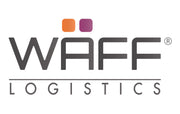Let's peel back the layers. At its heart, supply chain network design is the strategic blueprint for your entire logistics infrastructure. Think of it as creating the ultimate road system for your products, making sure they get from your hands to your customer's with the least friction and cost.
It’s about making sure the right products are in the right place, at the right time.
What Is Supply Chain Network Design, Really?
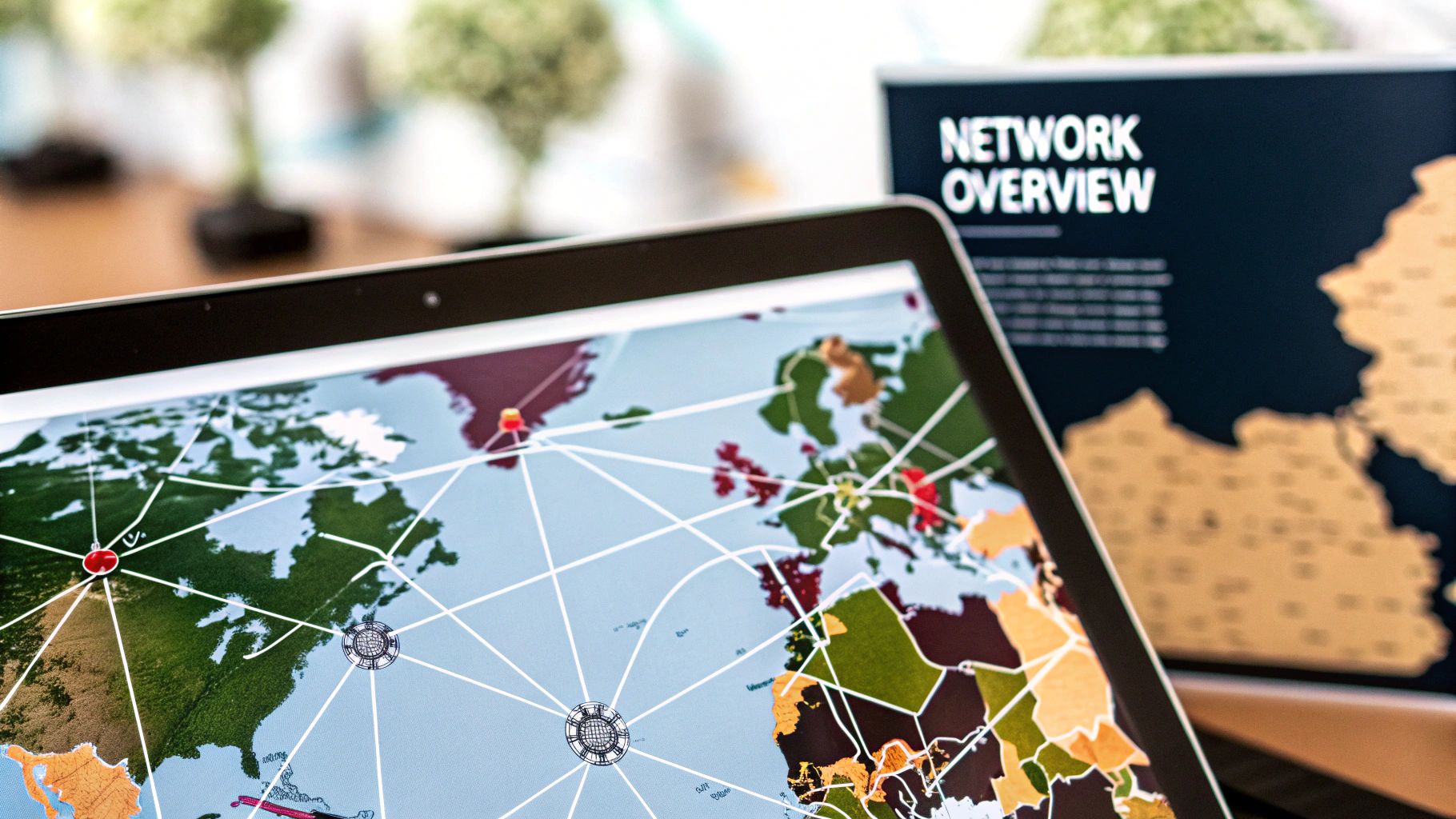
Forget the textbook definitions for a second. Let's stick with that road system analogy. A poorly planned network is like a city grid with constant traffic jams, endless detours, and frustrated drivers (your customers). A well-designed one, however, keeps everything flowing smoothly, even during peak season. That's what a great supply chain network design does for your business.
This isn't just about drawing lines on a map. It’s the high-level, strategic process of deciding exactly where to place your physical assets—your factories, warehouses, and distribution centres. It also dictates how much inventory to keep at each spot and which transportation lanes will get your products where they need to go. Get this right, and you've built a serious competitive advantage.
The Art of the Strategic Trade-Off
Great supply chain design is all about making smart trade-offs. You simply can't have it all—the absolute lowest cost, the fastest delivery on the planet, and limitless product availability. Every decision you make creates a ripple effect.
For instance, you could slash facility and labour costs by consolidating all your inventory into one massive, central warehouse. But what's the catch? Your transportation costs will likely shoot up, and delivery times will drag for customers living far from that single hub. It’s a classic tug-of-war between cost and service.
This brings us to the core challenge: balancing these competing priorities. Every business has to decide what matters most. Do you want to be the cheapest, the fastest, or the most reliable? Your network design is where these choices become reality.
The table below breaks down some of the fundamental choices you'll face.
Core Trade-Offs in Supply Chain Network Design
| Strategic Choice | Focus on Cost Reduction | Focus on Service Level & Speed |
|---|---|---|
| Warehouse Network | Fewer, larger, centralized warehouses to minimize overhead and labour costs. | More, smaller, decentralized warehouses located closer to customers for faster delivery. |
| Inventory Levels | Centralized inventory for slow-moving items to reduce holding costs and risk of obsolescence. | Higher inventory levels spread across multiple locations to ensure product availability and quick fulfillment. |
| Transportation | Slower, less expensive modes like rail or sea freight. Full truckload shipments are prioritized. | Faster, premium modes like air or expedited ground shipping. Less-than-truckload (LTL) shipments are common. |
| Manufacturing | Production in low-cost regions, even if they are far from the end market. | Production closer to major customer hubs ("near-shoring") to reduce lead times and shipping delays. |
Ultimately, there's no single "right" answer. The optimal design is the one that best supports your company’s unique goals and the promises you’ve made to your customers.
The Big Questions Your Network Design Must Answer
When you embark on a network design project, you’re making foundational decisions with long-term financial and operational consequences. These are the pillars of your logistical capability.
- Facility Roles and Locations: Should you operate many small distribution centres close to customers or a few massive regional hubs? Where are the best geographic spots to minimize transport costs and still hit your delivery targets?
- Inventory Positioning: Which products should you keep where? It might make sense to stock your bestsellers in multiple locations for speed, while slower-moving items are kept centrally to control costs.
- Sourcing and Production: Where should you actually make your products? This involves a complex analysis of labour costs, raw material access, and shipping expenses to your key markets.
- Transportation Flows: What are the most efficient routes for products moving from factories to warehouses and finally to customers? This includes picking the right mix of transport—road, rail, air, or sea.
The answers you land on today won't last forever. A network that was perfect five years ago might be bleeding money today because of shifts in population, new product lines, or skyrocketing fuel costs. That’s why modern supply chain network design isn’t a one-time project; it’s a continuous strategic exercise to keep your business sharp and competitive.
The Three Levers of Network Optimization
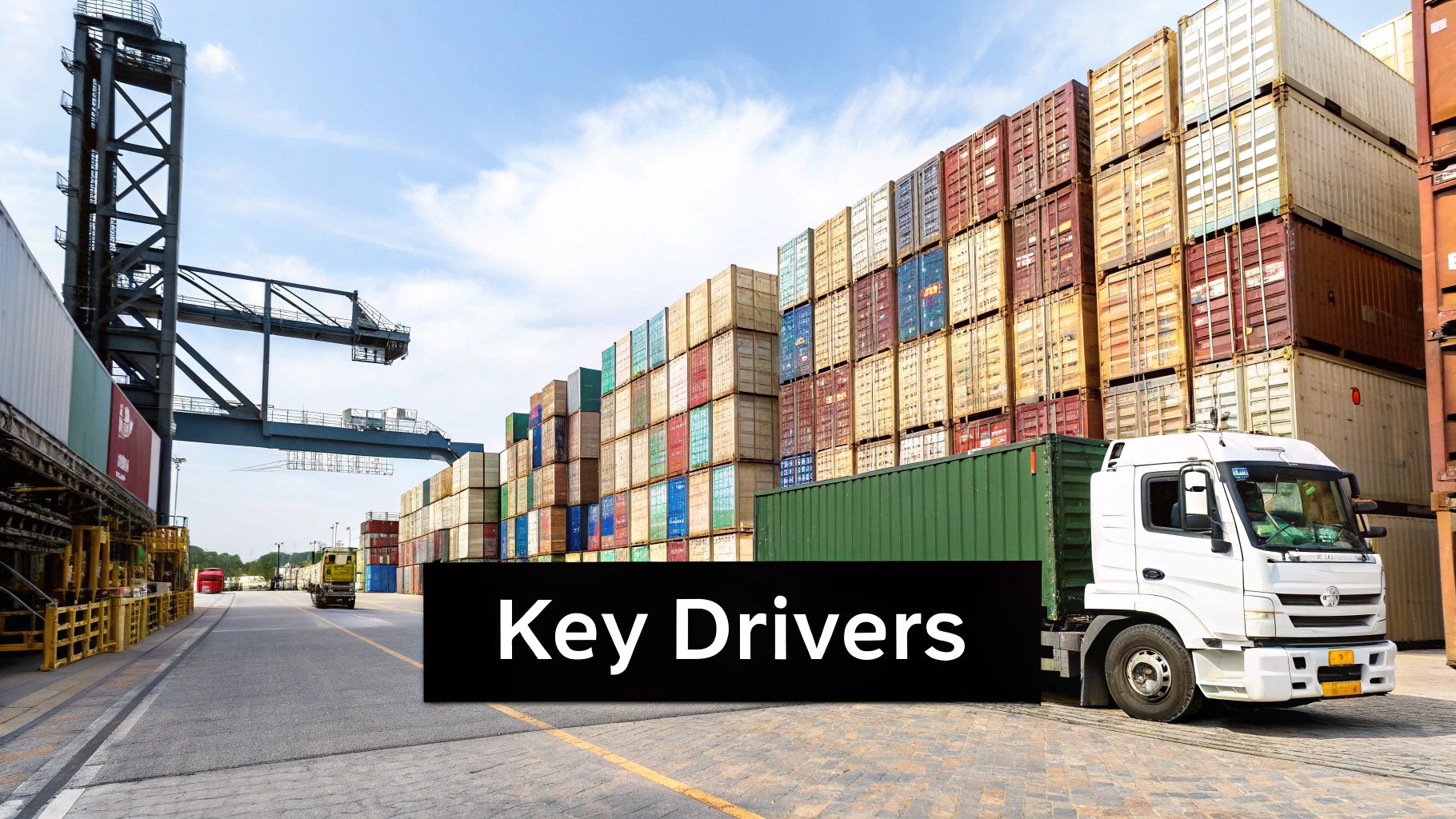
If you really want to get a handle on supply chain network design, you need to master three core levers: facilities, inventory, and transportation. I like to think of them as the controls in a cockpit. Adjust one, and the other two will react instantly. The real skill is in finding that perfect equilibrium for a smooth, efficient flight for your products.
The best companies don't just see these as separate lines on a budget; they see them as strategic tools to be manipulated for a serious competitive edge. It's all about building a synchronized system where every part works in concert to hit your goals, whether that’s delivering at lightning speed, slashing costs to the bone, or making your operations bulletproof.
Let's dig into how these three powerful levers play off one another.
Lever 1: Facilities and Their Strategic Role
First up are your facilities. These are the physical bones of your network—the factories, warehouses, and distribution centres. Deciding where to put them is one of the most consequential decisions you'll ever make. This goes far beyond just scouting for a cheap building; it's about placing your assets on the map like a grandmaster playing chess.
These aren't decisions you can easily undo. They are long-term commitments with enormous financial weight, so you have to get them right. You need to weigh:
- Proximity to Customers: Closing the distance to major customer hubs can massively shrink your last-mile delivery times and costs. In e-commerce, that's everything.
- Access to Labour and Infrastructure: You’re dead in the water without a skilled workforce and solid infrastructure like highways, ports, and rail access.
- Cost Drivers and Incentives: The sticker price on a building is just the start. You have to factor in local labour costs, tax breaks, and even what you'll pay for utilities.
For instance, research often shows labour cost is a massive driver, with one study giving it a statistical importance of 0.585 in strategic models. It’s no surprise that regions offering juicy tax incentives also have a strong pull. The level of local technology is also becoming a key consideration as businesses aim to build smarter, more connected facilities.
Lever 2: Inventory Placement and Flow
The second lever, inventory, is the very lifeblood of your operation. How you manage it and where you decide to position it directly shapes your cash flow and, just as importantly, your customer’s happiness. The constant battle is between the cost of holding inventory and the risk of running out of stock.
A rookie mistake is to treat all your inventory the same way. A truly optimized network strategically places different products based on how fast they sell. High-turnover, popular items? You might want those stocked in several forward locations for quick shipping. Slow-moving, specialty goods? Keep them at a central hub to minimize carrying costs.
This smart placement, what we call inventory positioning, ensures you have just enough product in all the right places. It stops you from tying up precious capital in goods that just sit there, while guaranteeing your bestsellers are always locked and loaded for shipment. To really nail this, you need a firm grasp on your key supply chain performance metrics, like inventory turns and carrying costs.
Lever 3: Transportation Modes and Routes
Finally, we have transportation. This is the connective tissue that links your facilities and gets your inventory moving. Pulling this lever means choosing the right modes—be it air, sea, road, or rail—and mapping out the smartest routes. Each mode brings its own unique trade-off between speed, cost, and capacity.
- Air Freight: The fastest way to move goods, but also the most expensive. Perfect for high-value or extremely time-sensitive products.
- Ocean Freight: The workhorse for bulk international shipments. It's slow, but incredibly cost-effective.
- Road (Trucking): Offers fantastic flexibility for domestic routes, striking a great balance between speed and cost.
- Rail: A champion for moving heavy, bulky goods over long distances on land, typically at a lower cost than trucking.
Optimizing transportation isn't about defaulting to the cheapest option. It’s about crafting a multi-modal strategy that actually backs up your promises to customers. For example, you might use ocean freight for the long journey from a factory in Asia to a port in Canada, shift to rail to move containers inland, and then rely on trucks for the final-mile delivery. This kind of intelligent routing is what separates a merely functional supply chain from a truly cost-effective and responsive one.
Your Step-By-Step Network Design Framework
Moving from abstract ideas to concrete action is where a supply chain network design project truly comes to life. This isn't about guesswork. It's a structured, methodical process that turns raw data into a powerful competitive advantage.
By following a proven framework, you ensure every critical variable is accounted for, leading to a network that’s not just cheaper to run, but also more resilient and responsive. Think of it as building a house: you need a solid blueprint before you can even think about pouring the foundation. This journey breaks down the complexity into manageable stages.
Step 1: Define Business Objectives and Constraints
Before you touch a single piece of data, you have to define what "success" actually looks like for your business. What are you really trying to achieve? Every great supply chain design project is anchored to clear, measurable goals.
These objectives become your North Star, guiding every decision you make down the line. Common goals often sound like this:
- Reduce total logistics costs by a specific target, like 15%.
- Improve customer service levels, such as guaranteeing two-day delivery to 95% of your customer base.
- Boost network resilience to better handle disruptions in a key region.
- Support entry into a new geographic market with a solid distribution plan.
At the same time, you have to be honest about your constraints. These are the real-world limits you’re working within—things like budget caps for new facilities, existing supplier contracts, or hard limits on production capacity.
Step 2: Gather and Validate Data
This is, without a doubt, the most critical—and often most time-consuming—phase of any network design project. The quality of your entire analysis rests squarely on the quality of your data. As the old saying goes, "garbage in, garbage out."
A common mistake is to rush through data collection to get to the "exciting" modelling part. But here's a reality check: industry experts often find that successful projects dedicate up to 70% of their time to meticulously gathering, cleaning, and validating data. A flawed dataset guarantees a flawed recommendation.
Your data gathering needs to be exhaustive, covering every part of your operation. This means digging into customer demand history, transportation rates, warehouse handling costs, inventory levels, supplier locations, and product details. Once you have it, this data must be scrubbed for errors and gaps to create a clean, reliable foundation for your model.
This process flow diagram shows how core elements like demand, location, and inventory are sequentially analyzed.
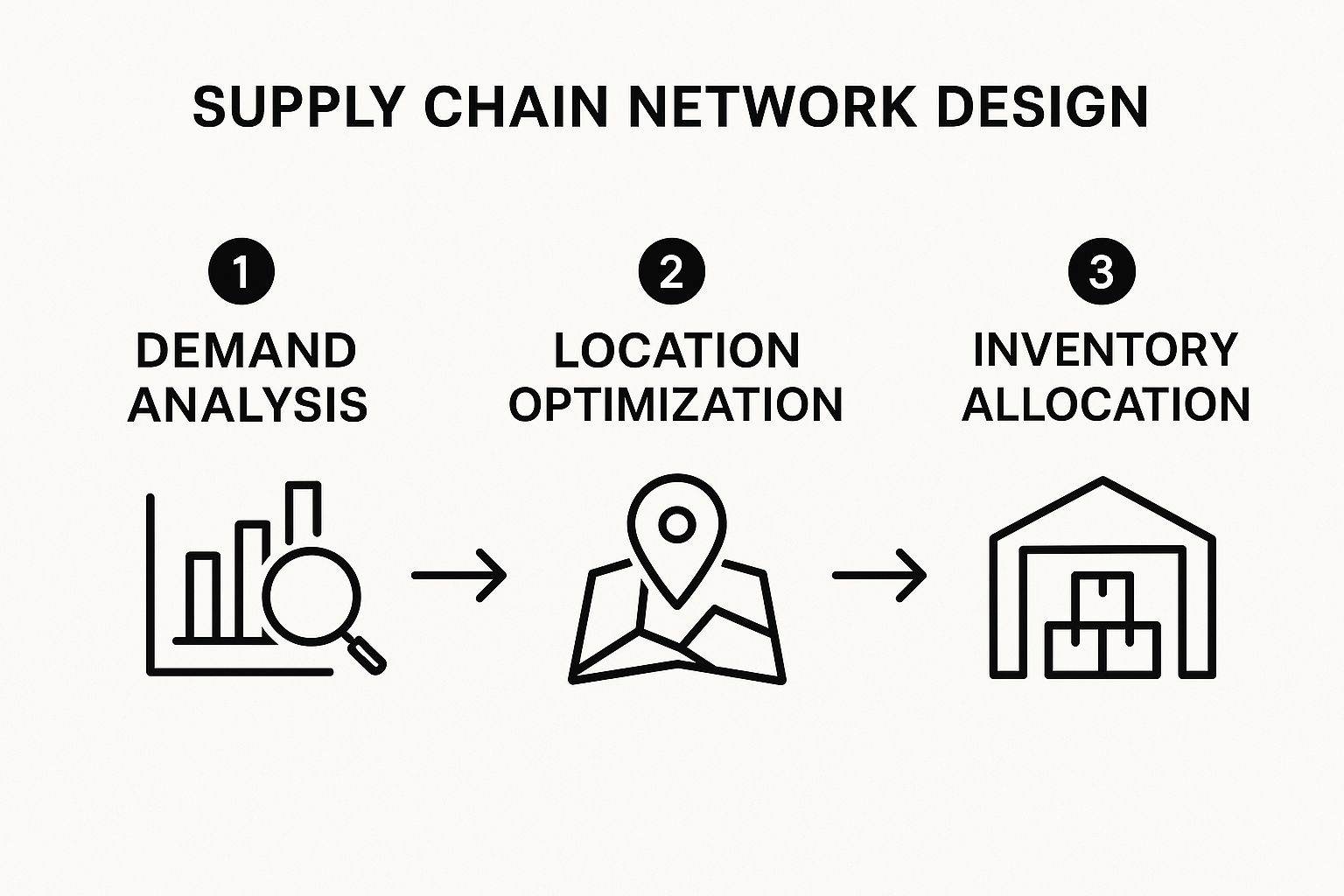
The image really drives home a key point: a solid understanding of demand has to come before you can make smart decisions about where to place facilities and how to manage your stock.
Step 3: Build a Baseline Model
With clean data in hand, your next move is to build a baseline model. This is essentially a digital twin of your current supply chain network. Its purpose is to give you an honest, unfiltered look at your present-day performance and costs.
This baseline is crucial for two reasons. First, it validates your data; if the model’s outputs (like total costs) line up with your actual financial reports, you know you can trust your numbers. More importantly, it provides the benchmark against which every future scenario will be measured.
Step 4: Run "What-If" Scenarios
Now for the fun part. This is where strategic thinking meets powerful analytics. Using your validated baseline model as a launchpad, you can explore all sorts of potential futures by running "what-if" scenarios. It's a completely risk-free way to test major strategic changes without spending a single dollar in the real world.
Powerful scenarios you could explore include:
- What's the real cost and service impact of opening a new distribution centre in Western Canada?
- How would our network hold up if a key supplier in Asia shuts down for a month?
- What happens to our bottom line if fuel costs suddenly jump by 25%?
Step 5: Analyze Results and Implement
Finally, you analyze the outputs from your various scenarios. You'll compare the projected costs, service levels, and resilience of each potential network against your baseline and those initial business objectives. This data-driven analysis is what forms the backbone of your final recommendation.
The result is a compelling business case for change, complete with an expected ROI and a clear implementation roadmap. Of course, a key part of this is managing the physical goods within your new network structure. To optimize this aspect, you can find valuable insights in this complete guide to warehouse inventory management. This shows that smart design isn't a one-off project, but a continuous cycle of improvement.
The True Business Value of a Modern Network
A well-executed supply chain network design offers so much more than just trimming expenses; it's one of the most powerful tools you have for building a competitive edge and lasting business resilience. It's a massive missed opportunity to view your network as a simple cost centre. Instead, think of it as a strategic asset that can drive growth, delight your customers, and insulate your operations from the chaos of the modern market.
The real payoff from modernizing your network shows up in many ways. It appears as better customer service through faster, more dependable deliveries. It also builds a sturdy framework that helps your business absorb and react to market shocks, whether that's a sudden port closure or an unexpected spike in demand. At its core, a strategic network is the backbone that holds up your entire growth strategy.
From Cost Centre to Growth Engine
An optimized network has a direct, positive impact on your bottom line, but not just by slashing transportation or warehousing budgets. When your logistics are running smoothly, you free up capital that can be poured back into innovation, marketing, or expansion. It’s like turning a necessary operational cost into a self-funding engine for growth.
This shift in thinking is critical. For instance, by strategically placing your distribution centres closer to key customer hubs, you aren't just cutting last-mile delivery costs—you're also dramatically shrinking delivery times. Faster shipping is a proven catalyst for customer loyalty and higher conversion rates, which directly fuels top-line revenue.
Building Unshakeable Resilience
Modern markets are unpredictable, and that volatility isn't going away. A network designed for resilience is your single best defence. This means building a system that doesn’t just withstand disruptions but can actually pivot and adapt on the fly. A rigid, outdated network can easily fracture under pressure, while a flexible one bends without breaking.
A resilient supply chain network is no longer a "nice-to-have"—it's an absolute necessity for business continuity. It's the difference between weathering a storm and being swept away by it. True resilience is the ability to seamlessly re-route shipments, activate alternate suppliers, or shift inventory between facilities when a crisis hits.
This kind of agility stops a problem in one corner of your network from spiralling into a full-blown catastrophe. For any business that depends on complex warehousing and distribution, mastering these operational flows is essential. Dive deeper into how these components work together in our guide on warehousing and distribution mastery.
Enhancing the Customer Experience
Ultimately, every single link in your supply chain leads to one make-or-break moment: the customer experience. A modern network design puts the customer at the absolute centre of the map. It's what ensures the promises you make on your website—like two-day shipping or real-time product availability—are promises you can consistently keep.
This reliability builds incredible brand trust. When customers know they can count on you for fast, dependable delivery, they don’t just come back; they become your biggest fans. This creates a powerful cycle of loyalty and growth, all powered by a logistics network that truly delivers.
For example, look at the optimization efforts in major logistics hubs. In California, a sharp focus on location analysis and tech integration led to a remarkable 15% improvement in average delivery times. This directly boosted customer satisfaction while simultaneously lowering operational costs. It's a perfect illustration of how network design is a direct investment in your customer relationships. By investing in your network, you are investing directly in the long-term success of your business.
Tackling Modern Supply Chain Challenges
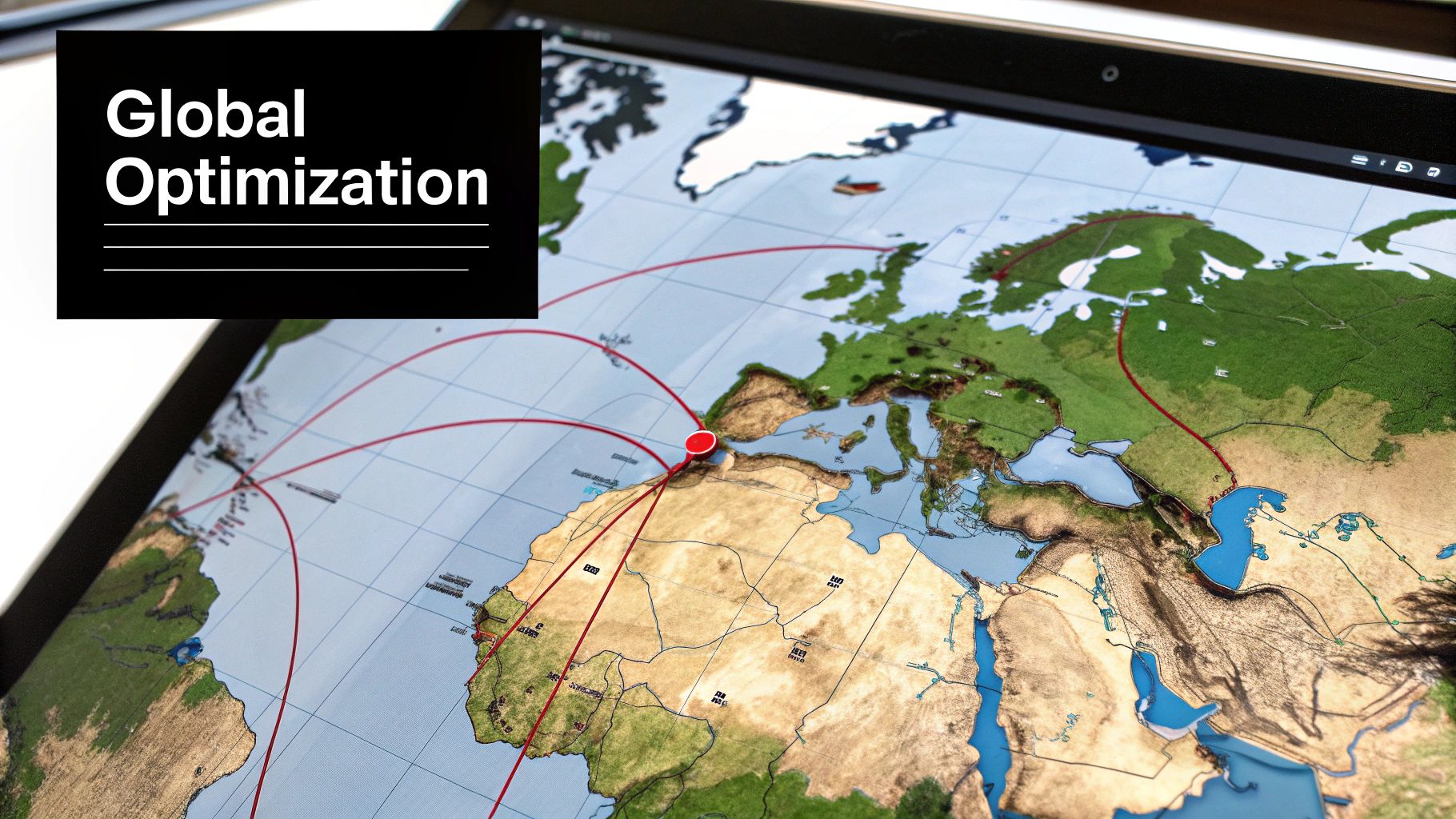
Anyone leading a supply chain today knows they're navigating a perfect storm. We're getting hit from all sides: soaring customer expectations for speed and transparency, escalating geopolitical and climate risks, and a powerful push toward greater sustainability. A network designed for yesterday’s realities just can’t keep up.
But here’s the thing: facing these issues head-on isn’t just about survival. It's about grabbing a serious competitive advantage. The smartest companies are adopting advanced tools and rethinking their strategies, turning today’s chaos into tomorrow’s opportunities. And their primary weapon in this new landscape? A well-executed supply chain network design.
Adopting Smarter, Predictive Technologies
The era of static, spreadsheet-based planning is officially over. The sheer complexity of what we're dealing with demands more dynamic, intelligent solutions. This is where artificial intelligence (AI) and machine learning (ML) are completely changing the game.
These technologies are transforming demand forecasting, taking it from educated guesswork to highly accurate, data-driven predictions. By analyzing everything from historical data and market trends to real-time signals like social media chatter, AI can anticipate demand shifts with stunning precision. This means we can place inventory exactly where it needs to be, slashing the risk of costly stockouts or overstock.
Another game-changing tool is the digital twin. Think of it as a virtual, living replica of your entire supply chain network, allowing you to simulate the impact of major changes in a completely risk-free environment.
With a digital twin, you can ask critical "what-if" questions and get data-backed answers in minutes, not months. What happens if a major port shuts down? How would adding a new warehouse in Montreal affect delivery times across Canada? A digital twin lets you test these scenarios, stress-test your network, and find the best path forward without disrupting a single real-world shipment.
Building Resilience Against Disruption
Disruptions aren't "black swan" events anymore; they're just a regular Tuesday in global commerce. A resilient network is designed to bend, not break. This means taking a multi-layered approach that goes way beyond just having a few backup suppliers.
Proactive risk management involves a few key moves:
- Diversifying Transportation Lanes: Relying on a single port or shipping mode is a massive vulnerability. A resilient network has pre-vetted alternatives ready to go at a moment's notice.
- Increasing Network Visibility: You simply can't manage what you can't see. Real-time tracking and data-sharing platforms give you a clear line of sight into your inventory at all times, letting you pivot quickly when delays pop up.
- Strategic Buffering: Building in smart buffers—whether that’s safety stock or temporary storage capacity—can absorb the shock of sudden backlogs or unexpected demand surges.
Take the California Supply Chain Success Initiative, for example. They tackled massive port congestion by expanding operating hours to 24/7, improving data access for real-time updates, and expanding buffer zones. The goal was to dramatically increase cargo throughput and minimize future bottlenecks. You can dive deeper into their approach in the official report on California's supply chain strategy.
Designing for Sustainability and Circularity
The pressure for environmental responsibility is coming from every direction, from customers to regulators. Forward-thinking companies are quickly realizing that a sustainable supply chain is also a more efficient and profitable one. This means designing for sustainability from the ground up, not just tacking it on as an afterthought.
This starts with optimizing transportation routes to cut down on fuel and carbon emissions—a core function of modern supply chain network design software. It also means strategically placing facilities to minimize travel distances and even choosing greener building materials and energy sources for warehouses.
Beyond that, the real leaders are now designing for a circular supply chain. This involves planning out your reverse logistics to efficiently handle returns, repairs, and recycling. By turning what was once a waste stream into a new value stream, companies don't just shrink their environmental footprint; they uncover new revenue opportunities. This proactive approach proves that a successful supply chain and a sustainable one are one and the same.
Answering Your Biggest Questions About Network Design
Thinking about redesigning your supply chain network can feel a bit like staring at a giant, complex puzzle. It's totally normal to have questions about when to start, what it will cost, and what tools you'll need. Getting clear, honest answers is the first step to feeling confident and building a logistics backbone that genuinely pushes your business forward.
Let's tackle some of the most common questions I hear from business leaders. My goal here is to give you straightforward, practical advice to help you get past any roadblocks and start making real progress.
How Often Should a Company Redesign Its Network?
There isn't a magic number, but the old rule of thumb was to do a major review every three to five years. Frankly, that advice is outdated. In a market that changes as fast as ours, waiting for a calendar reminder is a recipe for falling behind.
The real answer? You should review your network whenever your business goes through a significant change.
The smartest companies don't see this as a one-off project; they treat supply chain network design as a continuous process of improvement. Certain events should be immediate triggers for a deep dive:
- A major merger or acquisition: When you bring two distinct networks together, you have to re-evaluate everything to find efficiencies and get rid of overlapping costs.
- A big shift in customer demand: Have your customers moved to a new part of the country? Have online sales suddenly dwarfed your retail channels? Your network needs to follow your customers.
- Launching a new product line: New products often have unique storage or shipping needs that your current setup might not handle well, creating bottlenecks and driving up costs.
- Wild swings in operating costs: If fuel, labour, or real estate prices shoot up and stay there, a network that was once optimal can quickly become a major financial drain.
Today's leading organizations use modern software to keep a constant pulse on their network's health. They run "what-if" scenarios all the time, ensuring they're ready to pivot no matter what the market throws at them.
What Is the Biggest Mistake Companies Make?
Without a doubt, the single most costly mistake in network design is using bad data. The old saying "garbage in, garbage out" isn't just a cliché here—it's an ironclad law. If you build your strategy on a shaky foundation of flawed information, you're setting yourself up for failure.
Relying on old shipping rates, wildly optimistic demand forecasts, or incomplete product details will lead you straight to a bad decision. The recommendations from a model fed with poor data won't just be a little off; they can lead to catastrophic investments, like sinking millions into a new warehouse in completely the wrong province.
Successful network design is driven by data, but that data has to be pristine. In my experience, and experts agree, you should dedicate up to 70% of your project time just to collecting, cleaning, and validating your information. Rushing this phase to get to the "exciting" part is a mistake that can easily cost millions.
Can Small Businesses Benefit from Network Design?
Absolutely. The scale is different, but the core principles of supply chain network design deliver incredible value to businesses of every size. For a small or medium-sized business (SMB), optimization isn't about juggling a global web of facilities. It's about making smarter foundational decisions that can define your future.
A network design project for an SMB might focus on answering incredibly important questions like:
- In-house vs. Outsourcing: Should we keep fulfilling orders ourselves, or would partnering with a third-party logistics (3PL) provider be more cost-effective and help us grow?
- The Best Warehouse Location: If we only need one warehouse, where is the absolute best spot to place it to minimize shipping costs and reach our customers faster?
- Smarter Carrier Selection: Which shipping companies offer the right balance of price and service for our unique products and where our customers are located?
Even a simple analysis of these key decisions, sometimes done with nothing more than a well-built spreadsheet, can unlock huge savings and dramatically improve customer satisfaction. For a smaller company, those efficiencies aren't just nice to have—they're a powerful competitive weapon.
What Is the Role of Technology in Modern Design?
Technology is the engine that makes all of this possible. Think about all the variables: countless locations, products, costs, service levels, and transport options. It creates a puzzle with millions, sometimes billions, of possible answers. No person or team could ever solve that manually.
This is where specialized software comes in. These tools are built specifically to handle this level of complexity, using powerful algorithms to crunch all the numbers at once and pinpoint the mathematically best solution for your specific goals.
The most exciting piece of tech in this space is the digital twin. Imagine a perfect, dynamic, virtual copy of your entire supply chain. With it, you can:
- Test big ideas without real-world risk: Want to see the financial impact of opening a new distribution centre in Montreal? Curious about the savings from switching from truck to rail? A digital twin lets you model it all, risk-free.
- Prepare for disruptions: You can simulate what would happen if a key supplier's factory suddenly shuts down or a major shipping lane gets blocked. This allows you to build solid contingency plans before disaster strikes.
Now, artificial intelligence and machine learning are making these tools even smarter. They're enabling more accurate demand forecasting and helping predict risks, turning network design from a reactive chore into a forward-looking strategic advantage.
Ready to build a supply chain network that drives growth and resilience? At Waff Logistics Inc, we are your expert 3PL partner in Canada, offering premium warehousing, fulfillment, and distribution services. Our strategically located facilities and precision-focused team are ready to become the backbone of your business. Discover how our end-to-end solutions can optimize your operations by visiting us at Waff Logistics.
